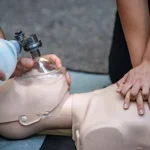
- Last Updated On: September 9, 2024
High Blood Pressure: Symptoms, Causes & Types
Table of Contents:
- Introduction
- What is High Blood Pressure?
- Symptoms of High Blood Pressure
Types of High Blood Pressure - Causes of High Blood Pressure
- Risk Factors for High Blood Pressure
- Complications of Untreated Hypertension
- Diagnosing High Blood Pressure
- Treatment Options for High Blood Pressure
- Conclusion
Did you know that almost half of adults in America have high blood pressure, and many are unaware of it? This is often called the “silent killer” because it shows no clear signs but can cause serious health consequences if ignored.
Therefore, knowing about high blood pressure is the first step to improving heart health. Are you prepared to take charge of your heart’s well-being? Let’s find out what high blood pressure is and learn how to protect yourself and those you care about.
What is High Blood Pressure?
High blood pressure is a serious health condition affecting 1.28 billion people under the age of 30-79 worldwide. It occurs when the force of blood against the walls of the arteries is dangerously high.
Blood pressure is measured in millimeters of mercury (mmHg) and is represented by two numbers: systolic pressure and diastolic pressure. A normal blood pressure reading is equal to or below 120/80 mmHg. However, when blood pressure readings consistently reach 130/80 mmHg or higher, it is classified as high blood pressure.
Symptoms of High Blood Pressure
One of the most challenging aspects of high blood pressure is that it often has no noticeable symptoms. Therefore, many people with hypertension feel perfectly fine and may not realize they have the condition until it’s detected during a routine medical checkup.
However, in some cases, people with severely elevated blood pressure may experience:
- Headaches,
- Shortness of breath,
- Nosebleeds,
- Flushing,
- Dizziness,
- Chest pain,
- Visual changes.
Note that these high blood pressure symptoms are not very evident, and measuring blood pressure is a quick and painless procedure. Thus, regular blood pressure checks are essential for the early detection and management of hypertension.
Types of High Blood Pressure
High blood pressure is classified into different types based on its relation to other medical conditions. Therefore, understanding the types of high blood pressure is crucial for effective management and treatment. There are several classifications:
- Primary Hypertension: This is the most common type, accounting for about 90-95% of cases. It develops slowly over many years and has no proper identifiable cause or relation with any other medical condition. Factors such as genetics, diet, and lifestyle contribute to its onset.
- Secondary Hypertension: This type is associated with an underlying health condition, such as kidney or heart disease, hormonal disorders, or certain medications. It can develop suddenly and is often more severe than primary hypertension. Identifying and treating the underlying cause can help manage this type of problem effectively.
- White-Coat Hypertension: Some individuals experience spikes in their blood pressure readings due to anxiety or stress in a medical setting. This phenomenon is known as white-coat hypertension. Thus, it is essential to monitor blood pressure at home to get an accurate assessment.
- Masked Hypertension: In contrast, masked hypertension occurs when blood pressure readings are normal in a clinical setting but elevated at home. This can lead to undiagnosed hypertension and potential health risks.
- Nocturnal Hypertension: This type is characterized by elevated blood pressure during sleep. It is associated with an increased risk of cardiovascular events and requires careful monitoring.
Causes of High Blood Pressure
The exact causes of high blood pressure are not always clear, especially in cases of primary hypertension. However, several factors can contribute to its development:
- Unhealthy Diet: A high sodium diet can lead to increased blood pressure. Reducing salt intake and consuming a balanced diet rich in fruits, vegetables, and whole grains is essential.
- Physical Inactivity: A sedentary lifestyle contributes to weight gain and increases the risk of hypertension. Regular physical activity helps maintain a healthy weight and lowers blood pressure.
- Obesity: Excess body weight puts additional strain on the heart and can lead to elevated blood pressure. Maintaining a healthy weight through diet and exercise is crucial for prevention.
- Smoking: Tobacco use damages blood vessels and raises blood pressure. Quitting smoking can significantly improve overall cardiovascular health.
- Alcohol Consumption: Excessive alcohol consumption can also result in increased blood pressure. However, moderation is key to limiting alcohol that can help manage hypertension.
- Chronic Conditions: Conditions such as diabetes, kidney disease, and sleep apnea can contribute to high blood pressure. Managing these underlying health issues is vital for controlling hypertension.
- Genetics: Family history plays a significant role in the risk of developing high blood pressure. If hypertension runs in your family, regular monitoring is even more critical.
Risk Factors for High Blood Pressure
Hypertension is caused by one single reason, but multiple factors put an individual at risk of developing it in later stages of life. The most common ones are:
- Age: The risk of hypertension increases as you get older, especially when you cross the age of 65.
- Race: African Americans are at higher risk of developing hypertension.
- Small amounts of Potassium in Your Diet: Potassium balances the amount of sodium in your cells. If you don’t balance it in your meals, a high sodium concentration might potentially cause hypertension.
- Stress: High levels of stress can also temporarily increase blood pressure.
Complications of Untreated Hypertension
Untreated hypertension can lead to serious health complications that can significantly impact quality of life and longevity. Here are some of the most critical complications associated with high blood pressure:
- Heart Disease
High blood pressure is a major risk factor for various heart conditions. It can lead to:
- Coronary Artery Disease: High blood pressure can damage the arteries that supply blood to the heart, leading to reduced blood flow and potentially causing chest pain (angina) or heart attacks.
- Heart Failure: The heart continually pumps blood in the vessels. High blood pressure can cause the heart muscle to weaken or stiffen, leading to heart failure.
- Left Ventricular Hypertrophy: The left ventricle thickens as it works harder to pump blood, increasing the risk of heart failure and arrhythmias.
- Stroke
High blood pressure can cause blood vessels in the brain to rupture or become blocked, leading to a stroke. This can result in permanent disability or death. There are two main types of strokes related to hypertension:
- Ischemic Stroke: This is caused by a blockage in a blood vessel supplying blood to the brain.
- Hemorrhagic Stroke: This is caused by a rupture of a weakened blood vessel in the brain.
- Kidney Damage
The kidneys filter waste from the blood, and high blood pressure can damage the blood vessels in the kidneys, leading to kidney disease or failure. This may require dialysis or a kidney transplant.
- Vision Loss
High blood pressure can affect the blood vessels in the eyes and can lead to conditions such as:
- Hypertensive Retinopathy: Damage to the retina can cause vision impairment or blindness.
- Choroidopathy: Fluid buildup under the retina can distort vision.
- Metabolic Syndrome
High blood pressure is also a component of metabolic syndrome, a cluster of conditions that increase the risk of heart disease, stroke, and diabetes. Individuals dealing with this condition have high blood pressure, high blood sugar, excess body fat around the waist, and even abnormal cholesterol levels.
- Cognitive Impairment and Dementia
High blood pressure can affect cognitive function and increase the risk of dementia. Reduced blood flow to the brain can lead to vascular dementia, characterized by memory loss and difficulty thinking clearly.
Diagnosing High Blood Pressure
As there are no severe symptoms associated with high blood pressure, many patients dealing with it remain undiagnosed for a long time. However, during a regular check-up, diagnosis of high blood pressure typically involves:
- Blood Pressure Measurement: Doctors use a sphygmomanometer to measure blood pressure on artery walls during each heartbeat. The readings consist of two numbers: the systolic pressure and the diastolic pressure. If the readings consistently show values at or above 130/80 mmHg, this indicates high blood pressure.
- Laboratory Tests: Healthcare providers may also perform blood and urine tests, as well as an electrocardiogram (ECG), to check for cholesterol, blood sugar, kidney function, and any possible heart irregularities.
- Echocardiogram: This non-invasive test uses sound waves to create images of the heart and assess its function. It can help detect any damage caused by high blood pressure.
Treatment Options for High Blood Pressure
When it comes to managing high blood pressure, healthcare providers typically work with patients to develop a comprehensive treatment plan. This plan is created around lifestyle changes for the patient, certain medications, or a combination of both. Here are the key components of treatment options for high blood pressure:
- Heart-Healthy Lifestyle Changes
Adopting a heart-healthy lifestyle is often the first step in managing high blood pressure. Key recommendations include:
- Dietary Changes: Following the DASH (Dietary Approaches to Stop Hypertension) eating plan can be highly effective. This diet emphasizes fruits, vegetables, whole grains, and low-fat dairy while reducing sodium intake. Research has proved that the DASH diet combined with a low-salt diet plan can help keep healthy blood pressure levels.
- Physical Activity: Regular exercise is crucial. Aim for at least 150 minutes of moderate aerobic activity each week. Even small amounts of physical activity, like walking for 10 minutes daily, can help lower blood pressure.
- Weight Management: Losing even a small amount of weight (5-10% of body weight) can improve blood pressure levels. Maintaining a healthy weight is essential for overall cardiovascular health.
- Quitting Smoking and Alcohol: Smoking cessation and reducing alcohol consumption is vital, as they can raise blood pressure and damage blood vessels.
- Stress Management: Learning stress management techniques, such as relaxation exercises or counseling, can improve both mental and physical health.
- Quality Sleep: The patient should also get 7-9 hours of quality sleep each night. Establishing a regular sleep routine can help improve overall health.
- Medications
If lifestyle changes alone do not adequately control blood pressure, healthcare providers may prescribe medications. Various types of drugs are employed to manage hypertension:
- Angiotensin-converting enzyme (ACE) Inhibitors: ACE inhibitors aid in the relaxation of blood vessels and inhibit the production of a hormone that narrows blood vessels.
- Angiotensin II Receptor Blockers (ARBs): Similar to ACE inhibitors, ARBs help relax blood vessels and lower blood pressure.
- Calcium Channel Blockers: These medications prevent calcium from entering the muscle cells of the heart and blood vessels, allowing blood vessels to relax.
- Diuretics: Often referred to as “water pills,” diuretics help remove excess sodium and fluid from the body, reducing blood volume and lowering blood pressure. Thiazide diuretics are commonly prescribed for hypertension.
Final Thoughts
High blood pressure, or hypertension, is a silent but serious condition that needs our focus and response. Managing this health challenge is crucial, as it lowers the chance of deadly problems like heart disease and stroke. Fundamental changes in how you live can transform your health. If you eat healthy foods and find ways to deal with stress, you can control your blood pressure and feel better overall.
Keep in mind that steady tracking matters. Going to the doctor and checking your blood pressure at home gives you useful information about how you’re doing and helps you stay on course. If you encounter individuals with respiratory or cardiac conditions, you should also be trained in CPR to deliver timely help. Don’t let high blood pressure or any other condition run your life—step up now!
Read more:




